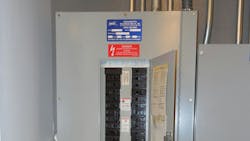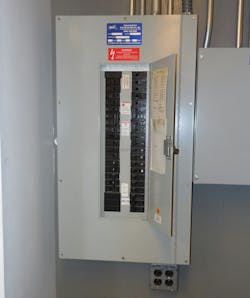Practically Speaking: Examining a Potentially Expensive Requirement
The idea to require a 125V, 15A or 20A receptacle outlet within 25 ft of panelboards, switchboards, switchgear, and motor control centers in other than dwelling units may not seem like a big deal at first. However, when we breakdown the requirements in Sec. 210.63, we may come to realize that this could sometimes be a really big deal — and a potentially very expensive requirement. These receptacles could be needed for power monitoring equipment, other portable equipment, or tools. An installation as basic as the one shown in the Photo (with the receptacle outlet located beneath the panelboard enclosure) could be problematic.
The requirements in Sec. 210.63(B)(2) do not allow the required receptacle outlet to be connected to the load side of the panelboard’s main breaker. This means the installation in the photo would not comply with the present requirement because the receptacle outlet is fed from this panelboard. In fact, none of the branch circuits in this panelboard could be used to provide power to the receptacle outlet required by Sec. 210.63, since all of those circuits are on the load side of the main breaker for this panelboard.
What if this is the only panelboard in the building? Well, in that case, the cost to comply with Sec. 210.63 goes way up. Adding a second panelboard with another 125V, 15A or 20A receptacle outlet fed from that second panelboard would be one way to comply. Of course, each receptacle outlet would need to be within 25 ft of the other panelboard to provide a Code-compliant installation.
What if the building only has 277V/480V power? I have worked in a few pump houses that only had panelboards feeding 480V motors and 277V lighting, but no 120V circuits. In buildings such as this, a transformer would be needed to provide the 120V circuits needed for the required receptacle outlets. But keep in mind the required receptacle outlets cannot be on the load side of the panelboard’s disconnecting means, so at least two panelboards would be required — each with a receptacle outlet installed to serve the other panelboards.
What if the building is fed by a feeder with one switchgear as the main disconnect for the whole building? Well, guess what? The required receptacle cannot be on the load side of the disconnect for that switchgear. Watch for revisions in the Code to provide some relief for this requirement in 2026.
About the Author

Russ LeBlanc
Owner
Russ started in the electrical trade as an apprentice in 1985. He worked his way up to become a Journeyman Electrician and then eventually became a Master Electrician and Licensed Construction Supervisor. In 1999 Russ become an Electrical Instructor for The Peterson School of Engineering in Massachusetts where he developed his passion for teaching, and quickly became Department Head of Electrical Instruction. Russ has taught thousands of apprentices, electricians, engineers, inspectors, and other electrical professionals during his career as an instructor. He continues to provide electrical professionals with Electrical Code seminars, Arc-Flash Awareness training seminars and educational material through his LeBlanc Consulting Services in North Reading, MA whose specialty is educating electricians. He has been an active member of the NFPA Electrical Section and has authored hundreds of National Electrical Code proposals and comments which have become Code rules to improve the safety for the electrical industry. Russ is also an IAEI certified Electrical Inspector.
Please visit www.russleblanc.net for more information.

